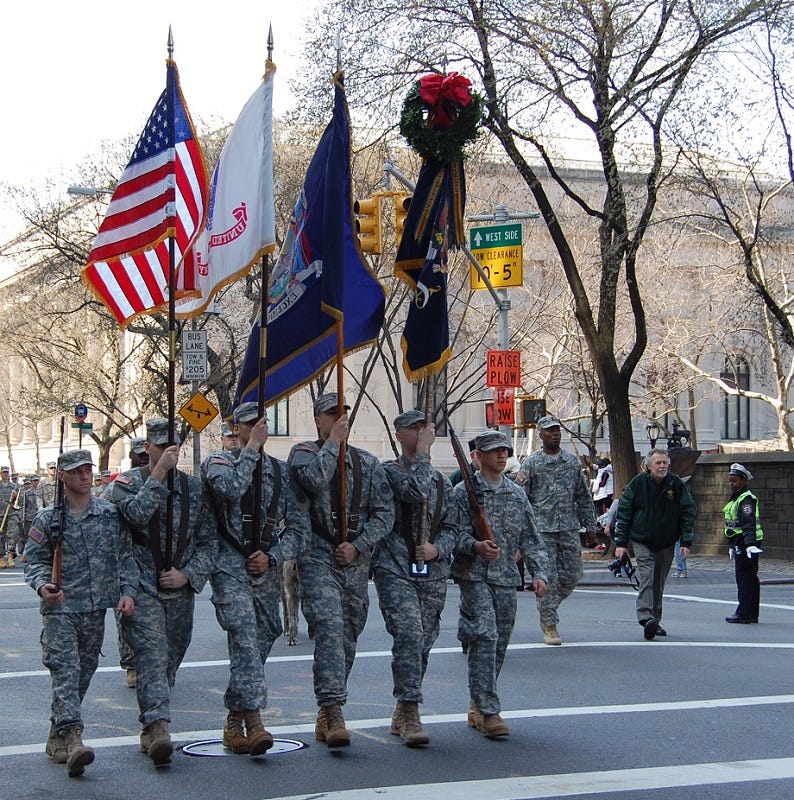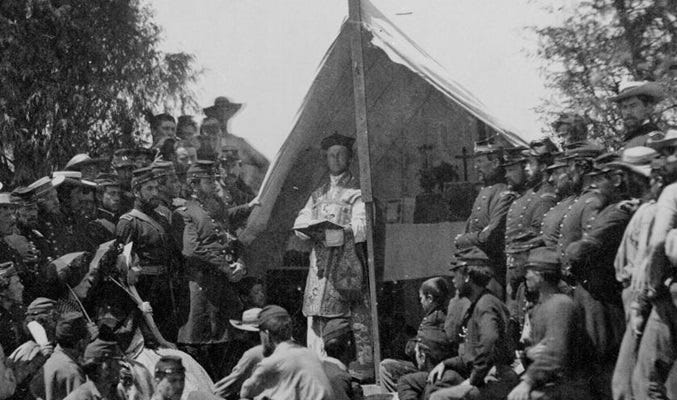
Tradition has it that it was General Robert E. Lee who gave this storied regiment its nickname, the Fighting 69th, after witnessing it repulse one of his toughest units, the Louisiana Tigers Brigade, at Malvern Hill during the 1862 Peninsula Campaign.
The 69th originated as one of three Irish regiments of the New York State Militia, recruited from the Irish immigrant population of New York. During the Civil War it was designated as the 69th Regiment of Infantry, New York State Volunteers and was one of three regiments forming the Army of the Potomac's Irish Brigade. The 69th gained imperishable fame in the Civil War, particularly during the Battle of Fredericksburg, where its gallant but unsuccessful attempt to storm the Confederate position on Mayre's Height (13 December 1862) inspired General George Pickett to write to his fiancé: "Your soldier's heart almost stood still as he watched those sons of Erin fearlessly rush to their death. The brilliant assault on Marye's Heights of their Irish Brigade was beyond description. Why, my darling, we forgot they were fighting us, and cheer after cheer at their fearlessness went up all along our lines."
At the Battle of Gettysburg, the 69th was practically wiped out during the fight for the Wheatfield. The Irish Brigade as a whole suffered so heavily that it was disbanded after the battle, but the 69th continued in service until the end of the war. After being rebuilt with fresh volunteers and draftees from New York City’s Irish slums, it returned to the Army of the Potomac and was present at Appomattox Court House, Virginia, for the surrender of General Robert E. Lee. Of the more than 2,000 regiments that served in the Union armies during the war, only six suffered higher casualties than the Fighting 69th.
During the First World War, when National Guard infantry regiments received 100-series numbers, the Fighting 69th became the 165th Infantry. As part of the 42nd Division—the Rainbow Division as it was called from the design of its shoulder sleeve insignia—the 165th fought with great distinction in the Western Front battles of 1918. In the Second World War the regiment served in the Pacific as a unit of the 27th Infantry Division, again with great distinction.
In 1993 the 165th was reorganized as the 1st Battalion, 69th Air Defense Artillery Regiment, but after numerous protests from current and former members it was converted back to an infantry battalion, becoming the 1st Battalion, 69th Infantry. As such it was called into federal service immediately after 9/11, responding to the Ground Zero site, sending troops to provide security for the US Military Academy, West Point, and later being deployed to Iraq and Afghanistan.
The Fighting 69th's home station is still its historic Manhattan armory on Lexington Avenue at 26th Street. Though today the battalion’s composition is quite diverse, the traditional link to Ireland remains strong. Anyone who serves in the 69th is deemed an honorary Irishman and the battalion parades every year on Saint Patrick’s Day. The photo at the head of this article shows the color guard of the Fighting 69th on St. Patrick’s Day 2012, bearing the National Color, the United States Army Flag, the flag of New York State and the Organizational Color of the regiment with a garland of shamrocks to mark the occasion.





